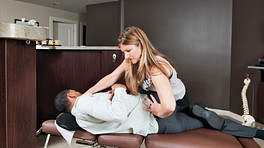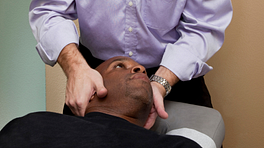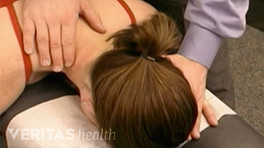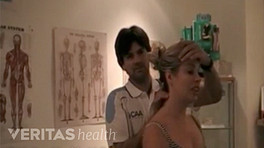Chiropractic adjustment (spinal manipulation) of the cervical spine is usually accomplished with the patient either lying down on his or her back, or in a seated position.
See Understanding Spinal Manipulation
Alternatively, the patient may be placed in a prone position (lying face down), an approach often used in lower cervical/upper thoracic vertebral and rib/vertebra ("costovertebral") joint manipulation.
To further describe this approach, the lying on the back or sitting methods include the following:
- While fully relaxed, the vertebra being manipulated is isolated with the chiropractor's index or 3rd finger, while the other hand comfortably supports the weight of the head or reinforces the contact hand.
- The head is then either rotated (called a "rotatory technique") or flexed sideways without rotation (called a "break technique"). Often, a combination of the two is used. A traction or stretch direction may also be employed. The choice of technique is based on patient comfort and doctor preference and experience.
- When all the "slack" is taken out and this pre-manipulation position is determined to be comfortable, the manipulation (and/or mobilization) is applied, depending on the assessment of the patient.
- If comfortable, a high-velocity, low-amplitude thrust is applied by the chiropractor.
In This Article:
- Chiropractic Manipulation for the Cervical Spine
- Typical Cervical Problems Treated by Chiropractic
- Spinal Manipulation for Cervical Joint Dysfunction
- Gentle Chiropractic Techniques for Neck Pain
- Chiropractic Adjustment of the Cervical Spine (Neck) Video
Instrument Assisted Adjustment
Some chiropractors may also use tools as part of the adjustment technique. Probably the most commonly used tool is the "Activator." The Activator is a small, spring-loaded hand-held device that may be used to adjust a cervical vertebra.
See Activator Method Chiropractic Technique
The Activator is just one example; there are other instrument-assisted manipulative devices also utilized by chiropractors, some of which offer more of a pulsating stimulation to adjust the cervical vertebral segment.
Cracking Sound During the Adjustment
The HVLA manipulation creates a cracking sound associated with gas release during joint movement.
The HVLA manipulation usually results in a release, called cavitation, which is created in part by gas escaping from the joint capsule when the joint is moved quickly within its passive range of motion, well within the tissue boundaries.
This type of chiropractic adjustment creates the typical cracking sound that is often associated with joint manipulation. It sounds similar to cracking one's knuckles.
While this cracking description of a chiropractic high-velocity, low-amplitude thrust may give an impression of something that is uncomfortable, many patients find the sensation is relieving and may provide immediate relief of painful symptoms.
On the other hand, some patients will feel some discomfort after treatment, sometimes described as soreness, stiffness, or aching, similar to when a new activity has taken place and soreness is present for a day or two. This discomfort is usually short-lived and usually does not interfere with normal daily activities. Chiropractors will often recommend using an ice pack as part of the anti-inflammatory home therapy that will help reduce any post-treatment soreness.
See Reactions Following a Chiropractic Adjustment
There are some patients who simply do not feel comfortable with and/or do not tolerate the cracking sound or twisting/side bending movement involved with the traditional chiropractic adjustment, especially in the cervical spine area. For these patients, gentle, less forceful approaches such as mobilization may be preferred.
Risks Associated with Cervical Manipulation
There is also a controversial issue of a risk that has been associated with HVLA cervical manipulation and stroke. The latest studies report that people that have a stroke at a chiropractic facility are already in the process of having the stroke when they present - and this is true at any health care facility - DC, MD, DO, etc. It is unlikely that additional risk exists with HVLA cervical manipulation in this patient population and, the occurrence rate of this happening is extremely rare.
When compared to other forms of treatment for neck pain, such as taking ibuprofen or other NSAIDs (non-steroidal anti-inflammatory drugs), the chances of significant side effects and death is higher (e.g. bleeding from a gastric ulcer, as well as liver and/or kidney disease). Two recent studies reported that there is no change in blood flow in the main arteries of the neck during a HVLA cervical adjustment (the vertebral arteries and the internal carotid arteries). There are no studies that support the notion that cervical spine manipulation causes stroke. 1 Cassidy, J. D., Boyle, E., Cote, P., He, Y., Hogg-Johnson, S., Silver, F. L., & Bondy, S. J. (2008). Risk of Vertebrobasilar Stroke and Chiropractic Care. European Spine Journal, 17(Suppl 1), 176–183. www.ncbi.nlm.nih.gov.
A thorough discussion or review of the medical literature on this topic is beyond the scope of this article. For patients who are concerned about this issue, a gentle, less forceful approach such as mobilization may be preferred and can be requested.
Read more: Spinal Mobilization: Gentle Chiropractic Techniques
- 1 Cassidy, J. D., Boyle, E., Cote, P., He, Y., Hogg-Johnson, S., Silver, F. L., & Bondy, S. J. (2008). Risk of Vertebrobasilar Stroke and Chiropractic Care. European Spine Journal, 17(Suppl 1), 176–183. www.ncbi.nlm.nih.gov.










